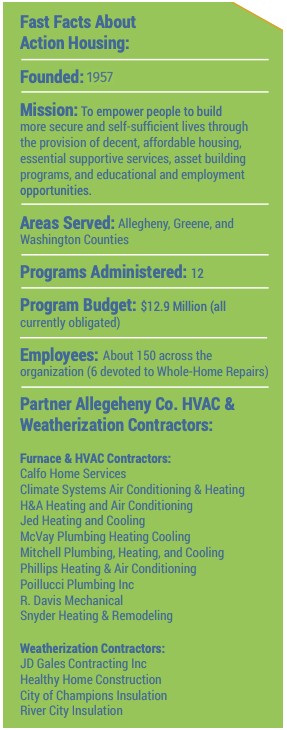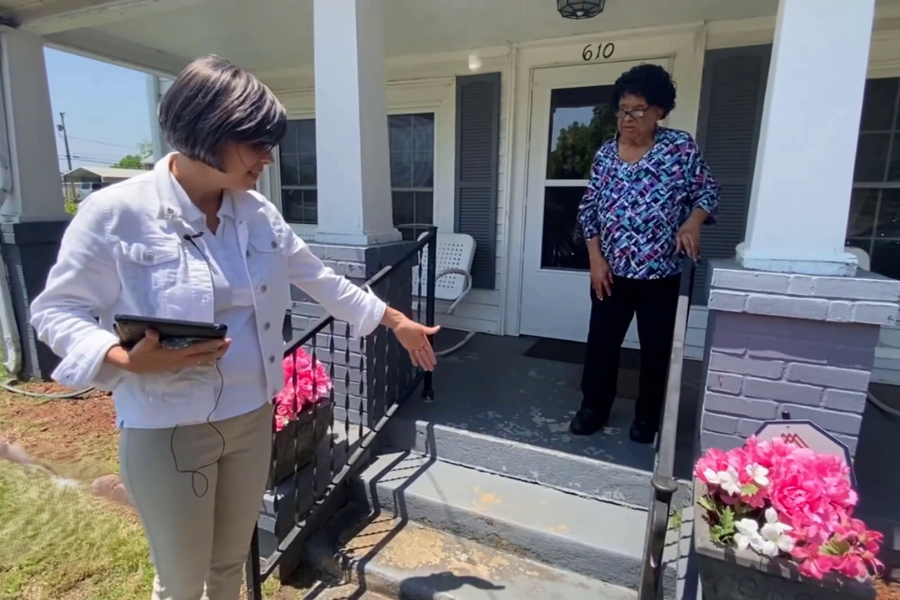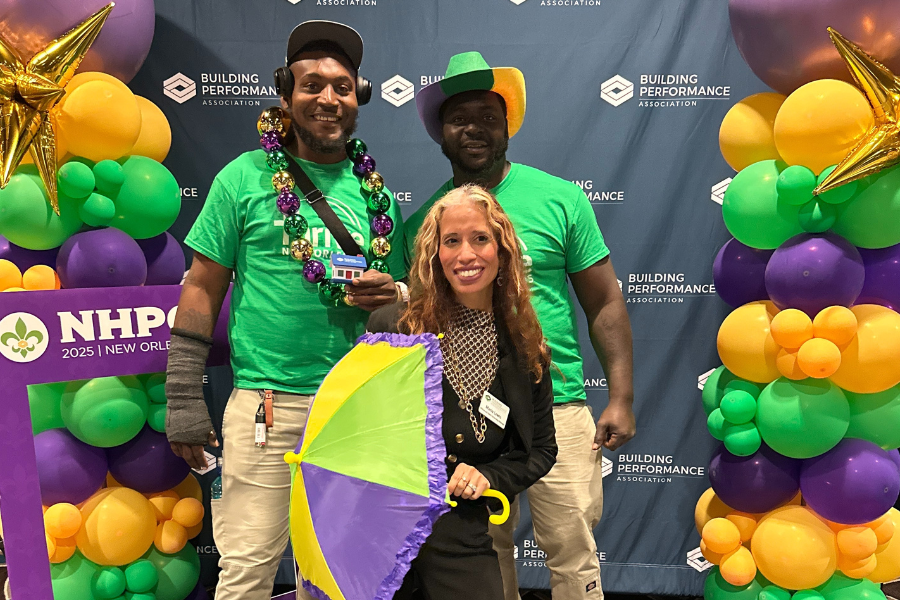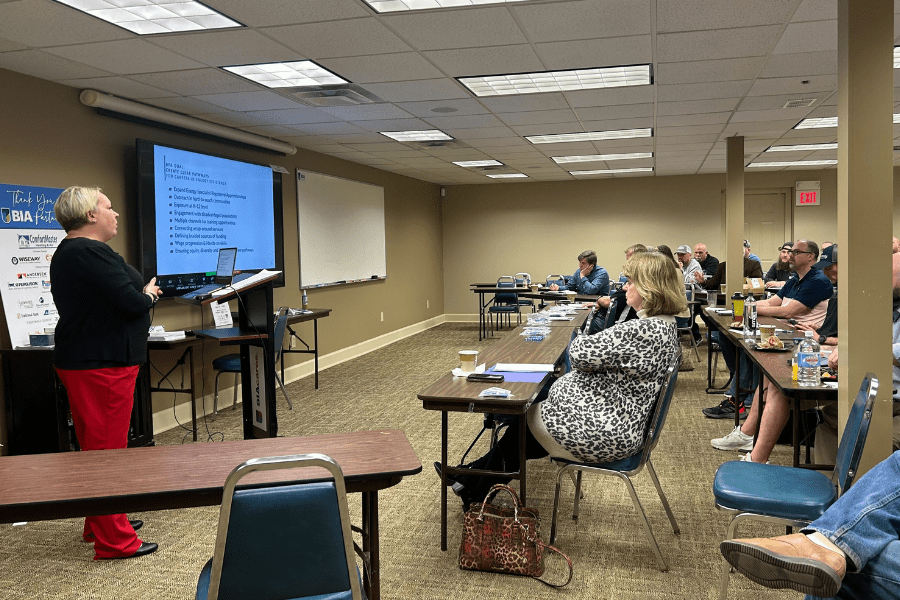Nov 21, 2024
An Interview with Action Housing’s Weatherization Expert
Patty DiGuilio on weatherization, her career, and the future of the industry

Weatherization is a great investment. According to the Department of Energy, every dollar invested in weatherization results in $1.72 in energy benefits and $2.78 in nonenergy benefits. So, where do you turn for weatherization services?
If you’re a low- to moderate-income household in Allegheny County, you turn to Action Housing—and you turn to Patricia “Patty” DiGuilio. Patty is Action Housing’s Weatherization Program Manager, where she runs the nonprofit’s Weatherization Assistance Program (WAP) and similar programs.
Energy Efficiency Stories sat down with Patty earlier this spring to talk about Action Housing’s work, her extensive experience in the weatherization industry, and what could come next for Pennsylvania’s weatherization workforce.
What’s your current position with Action Housing?
Right now, I am the weatherization administrator at Action Housing for Allegheny County. I’m dealing with the state weatherization program, the LIHEAP crisis program, their cooling program, and things like that. Day-to-day, I’m the liaison between our field staff and the contractors, following jobs from referral all the way through final inspection.
Previously, I was an energy auditor with Action Housing in Washington and Greene Counties. And I come from a background of weatherization work with utility programs.
So how do people get connected with you for weatherization services?
They can request an application. Often they hear about us through word of mouth; sometimes it’s their DHS caseworker sending out a letter. Sometimes they’re getting assistance for something else. If a furnace breaks and they’re calling into the LIHEAP office, we will send them a weatherization application.
What’s the typical applicant like?
The only thing that ties them all together is that they’re lower-income. You really do get a variety of people. You get people who are retired, or they might be low-income because a spouse has passed and they don’t have two incomes coming in. You get young, old, you get veterans, you get disabled people.

What kinds of services are people getting through a weatherization program?
With weatherization, our focus is on energy efficiency, increasing comfort in people’s homes, reducing their energy bills. So our big focus would be insulation, adding it in the attic if possible, adding it to the walls, doing air sealing, trying to stop air from coming into the home. Oftentimes we do a lot of air sealing in the basements, in addition to weather stripping and air sealing around doors and windows.
When it comes to HVAC and furnaces, sometimes we’ll refer them to the LIHEAP crisis program and sometimes we do HVAC work straight through the weatherization program. And we do some health and safety work as well.
And does Action Housing do the work or do you have contractors come in?
We have a group of HVAC contractors that we work with. And then we also have weatherization contractors that do the insulation and air sealing. We also have contractors for any home repairs necessary to get that weatherization work started.
We’re always looking for more weatherization contractors. HVAC contractors are easier to find. If you’re repairing or replacing a furnace, that’s pretty standard practice in different markets and homes. Weatherization contractors are a little bit trickier because we’re not just a home repair service. The work is focused on energy efficiency, and that requires some special training.
What do you think could help get more weatherization contractors into the field?
More training for people getting into construction from the get-go. There are some standard classes that need to be taken for weatherization. I know that the state is trying to develop an apprenticeship program and a workforce training program, and that would be helpful.
I also think that there’s such a heavy emphasis now on college, so you’re not getting as many people going into the trades. And I think that we could be reaching younger people who might want to go into construction or the trades and introducing them to this line of work earlier.
Why do you like working in weatherization?
In the field, I really liked the day-to-day. I like helping people. When you’re in the field, you’re always learning because you’re always coming across something different. It keeps you on your toes. You run into challenging situations with just the construction of people’s homes. Sometimes they might not have a basement; they have a crawl space. You have to try to figure out the best way to make their home more comfortable.
Some customers are extremely grateful, super nice, and that always makes you feel like you’re accomplishing something. Because you’re helping lower their energy bills for them. Then we’re also helping the environment, right? We’re trying to use fewer fossil fuels, use less energy.
How did you get started?
I started working for a group called Conservation Consultants, Inc. that dealt with weatherization and utility programs. Once you’re in this field, you just move around to different areas of it. Once I got in with the utility programs, that’s when I started doing more full home assessments, more energy audits, replacing light bulbs and refrigerators. That eventually progressed with more training and time in the field to doing full energy audits and writing up work scopes for contractors to get work done in people’s homes.
What advice do you have for someone interested in a weatherization career?
It can be difficult to find the training on your own. So try to find and join an organization that facilitates training. And always seek on-the-job training. On-the-job training is key. You can watch videos, you can take classes, you can take tests. But that doesn’t prepare you for what you see in this job, especially if you’re a field worker.
And I would say to ask as many questions as possible. Don’t be afraid to ask questions. Because there’s always somebody who may have encountered something that you’re seeing who can help you. And take photos.
Energy efficiency has a gender diversity issue right now—fewer than 30% of the current EE workforce are women workers. Do you have any advice for women who are considering this field?
I think you can’t be afraid of it. Because you’re right, in most of my training classes and later on weatherization crews, I was often the only woman.
You need to jump in. You can’t be timid. You are not going to always know what you’re doing, and that’s okay, but you’re never going to know unless you try. If you’re handy at all, if you don’t mind doing DIY projects around the house, that’s a good skill set because it makes you less timid in this line of work. It can be intimidating when it’s all men. But you’re there too. They’re learning, and you’re learning; you’re all learning together.
What do you think is coming next for Pennsylvania’s weatherization industry?
There’s such a big stock of old homes in this area, that I don’t think there’ll ever be a shortage of work in this field. But as there’s more and more funding and more and more housing being serviced, some of the measures might need to change. We’re already running into it now where we’ll go to a home for an audit, and maybe a utility has already switched out all the light bulbs.
I think there’s going to be a shift in the amount of money being spent in people’s homes, to not focus so much on the low-hanging fruit that’s already been accomplished, but making bigger upgrades. Like switching their heating systems over to heat pumps, and maybe doing more generalized home repairs or health and safety measures in homes that aren’t in the best shape, so that we are able to do weatherization work in them. I see us spending more money per job so we can get more accomplished once we’re in there.
This article was originally featured in Energy Efficiency Stories and is republished with permission.





